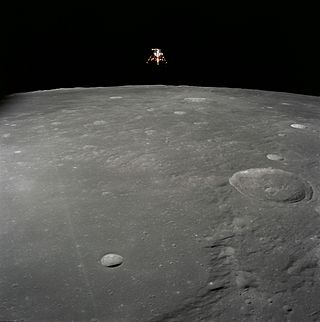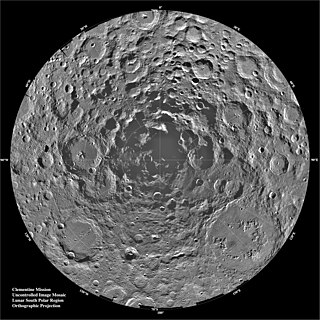Related Research Articles

The Goddard Space Flight Center (GSFC) is a major NASA space research laboratory located approximately 6.5 miles (10.5 km) northeast of Washington, D.C. in Greenbelt, Maryland, United States. Established on May 1, 1959 as NASA's first space flight center, GSFC employs approximately 10,000 civil servants and contractors. Named in recognition of American rocket propulsion pioneer Robert H. Goddard, it is one of ten major NASA field centers. GSFC is partially within the former Goddard census-designated place; it has a Greenbelt mailing address.

The Vision for Space Exploration (VSE) was a plan for space exploration announced on January 14, 2004 by President George W. Bush. It was conceived as a response to the Space Shuttle Columbia disaster, the state of human spaceflight at NASA, and as a way to regain public enthusiasm for space exploration.

The far side of the Moon is the lunar hemisphere that always faces away from Earth, opposite to the near side, because of synchronous rotation in the Moon's orbit. Compared to the near side, the far side's terrain is rugged, with a multitude of impact craters and relatively few flat and dark lunar maria ("seas"), giving it an appearance closer to other barren places in the Solar System such as Mercury and Callisto. It has one of the largest craters in the Solar System, the South Pole–Aitken basin. The hemisphere has sometimes been called the "dark side of the Moon", where "dark" means "unknown" instead of "lacking sunlight" – each side of the Moon experiences two weeks of sunlight while the opposite side experiences two weeks of night.

A Moon landing or lunar landing is the arrival of a spacecraft on the surface of the Moon. This includes both crewed and robotic missions. The first human-made object to touch the Moon was the Soviet Union's Luna 2, on 13 September 1959.

The physical exploration of the Moon began when Luna 2, a space probe launched by the Soviet Union, made an impact on the surface of the Moon on September 14, 1959. Prior to that the only available means of exploration had been observation from Earth. The invention of the optical telescope brought about the first leap in the quality of lunar observations. Galileo Galilei is generally credited as the first person to use a telescope for astronomical purposes; having made his own telescope in 1609, the mountains and craters on the lunar surface were among his first observations using it.
Lunar habitation is any long-term activity on the Moon, establishing human habitation on the Moon. Therefore, it is more than the particular surface space habitats and more specific than the moonbases which can consist of any facility.

Third-party evidence for Apollo Moon landings is evidence, or analysis of evidence, about the Moon landings that does not come from either NASA or the U.S. government, or the Apollo Moon landing hoax theorists. This evidence provides independent confirmation of NASA's account of the six Apollo program Moon missions flown between 1969 and 1972.

The Lunar Atmosphere and Dust Environment Explorer was a NASA lunar exploration and technology demonstration mission. It was launched on a Minotaur V rocket from the Mid-Atlantic Regional Spaceport on September 7, 2013. During its seven-month mission, LADEE orbited around the Moon's equator, using its instruments to study the lunar exosphere and dust in the Moon's vicinity. Instruments included a dust detector, neutral mass spectrometer, and ultraviolet-visible spectrometer, as well as a technology demonstration consisting of a laser communications terminal. The mission ended on April 18, 2014, when the spacecraft's controllers intentionally crashed LADEE into the far side of the Moon, which, later, was determined to be near the eastern rim of Sundman V crater.

The Lunar Reconnaissance Orbiter (LRO) is a NASA robotic spacecraft currently orbiting the Moon in an eccentric polar mapping orbit. Data collected by LRO have been described as essential for planning NASA's future human and robotic missions to the Moon. Its detailed mapping program is identifying safe landing sites, locating potential resources on the Moon, characterizing the radiation environment, and demonstrating new technologies.

The National Aeronautics and Space Administration is an independent agency of the U.S. federal government responsible for the civil space program, aeronautics research, and space research. Established in 1958, NASA succeeded the National Advisory Committee for Aeronautics (NACA) to give the U.S. space development effort a distinctly civilian orientation, emphasizing peaceful applications in space science. NASA has since led most American space exploration, including Project Mercury, Project Gemini, the 1968–1972 Apollo Moon landing missions, the Skylab space station, and the Space Shuttle. NASA currently supports the International Space Station and oversees the development of the Orion spacecraft and the Space Launch System for the crewed lunar Artemis program, the Commercial Crew spacecraft, and the planned Lunar Gateway space station.

The lunar south pole is the southernmost point on the Moon. It is of interest to scientists because of the occurrence of water ice in permanently shadowed areas around it. The lunar south pole region features craters that are unique in that the near-constant sunlight does not reach their interior. Such craters are cold traps that contain a fossil record of hydrogen, water ice, and other volatiles dating from the early Solar System. In contrast, the lunar north pole region exhibits a much lower quantity of similarly sheltered craters.

The Far Ultraviolet Camera/Spectrograph (UVC) was one of the experiments deployed on the lunar surface by the Apollo 16 astronauts. It consisted of a telescope and camera that obtained astronomical images and spectra in the far ultraviolet region of the electromagnetic spectrum.
The International Lunar Observatory (ILO) is a private scientific and commercial lunar mission by International Lunar Observatory Association of Kamuela, Hawaii to place a small observatory near the South Pole of the Moon to conduct astrophysical studies using an optical telescope and possibly include an antenna dish. The mission aims to prove a conceptual design for a lunar observatory that would be reliable, low cost, and fast to implement. A precursor mission, ILO-X consisting of two small imagers, is set to launch in 2023 aboard the Intuitive Machines IM-1 mission to the Moon south pole region. It is hoped to be a technology precursor to a future observatories on the Moon, and other commercial initiatives.
MoonLIGHT is a laser retroreflector developed as a collaboration primarily between the University of Maryland in the United States, and the Italian National Institute for Nuclear Physics - National Laboratories of Frascati (INFN-LNF) to complement and expand on the Lunar Laser Ranging experiment started with the Apollo Program in 1969. MoonLIGHT was planned to be launched in July 2020 as a secondary payload on the MX-1E lunar lander built by the private company Moon Express. However, as of February 2020, the launch of the MX-1E has been canceled. In 2018 INFN proposed to the European Space Agency (ESA) the MoonLIGHT Pointing Actuators (MPAc) project and was contracted by ESA to deliver it. MPAc is an INFN development for ESA, with auxiliary support by the Italian Space Agency (ASI) for prototyping work. In 2021, ESA agreed with NASA to launch MPAc with a Commercial Lunar Payload Services (CLPS) mission. Nova-C, the lander on which MPAc will be integrated, is designed by Intuitive Machines and the landing site is Reiner Gamma. The launch expected date is in 2024.
Lunar Ultraviolet Cosmic Imager (LUCI) is a small planned telescope that will be landed on the Moon to scan the sky in near UV wavelengths. It is a technology demonstrator developed by the Indian Institute of Astrophysics, and it was planned to be one of several small payloads to be deployed by the commercial Z-01 lander developed by TeamIndus in partnership with OrbitBeyond. The mission was planned to be launched in 2020 as part of NASA's Commercial Lunar Payload Services (CLPS). On 29 July 2019 OrbitBeyond announced that it will drop out of the CLPS contract with NASA, meaning that the 2020 launch was canceled and it is unknown whether the mission will ever take place.

Commercial Lunar Payload Services (CLPS) is a NASA program to contract transportation services able to send small robotic landers and rovers to the Moon's south polar region mostly with the goals of scouting for lunar resources, testing in situ resource utilization (ISRU) concepts, and performing lunar science to support the Artemis lunar program. CLPS is intended to buy end-to-end payload services between Earth and the lunar surface using fixed priced contracts. The program was extended to add support for large payloads starting after 2025.

The Lunar Crater Radio Telescope (LCRT) is a proposal by the NASA Institute for Advanced Concepts to create an ultra-long-wavelength radio telescope inside a lunar crater on the far side of the Moon.
References
- ↑ Talbert, Tricia (March 6, 2023). "NASA, Department of Energy Join Forces on Innovative Lunar Experiment". NASA.
- ↑ "LuSEE Night".
- ↑ "Department of Energy and NASA Join Forces on Innovative Lunar Experiment". Energy.gov.
- ↑ "Lunar Surface Electromagnetic Experiment (LuSEE) - Night | BNL Cosmology & Astrophysics Group". www.cosmo.bnl.gov.
- ↑ Sutter, Paul M. (January 30, 2023). "Astronomers Prepare to Launch LuSEE Night, A Test Observatory on the Far Side of the Moon".
- ↑ Bale, Stuart D.; Bassett, Neil; Burns, Jack O.; Jones, Johnny Dorigo; Goetz, Keith; Hellum-Bye, Christian; Hermann, Sven; Hibbard, Joshua; Maksimovic, Milan; McLean, Ryan; Monsalve, Raul; O'Connor, Paul; Parsons, Aaron; Pulupa, Marc; Pund, Rugved; Rapetti, David; Rotermund, Kaja M.; Saliwanchik, Ben; Slosar, Anze; Sundkvist, David; Suzuki, Aritoki (January 24, 2023). "LuSEE 'Night': The Lunar Surface Electromagnetics Experiment". arXiv: 2301.10345 [astro-ph.IM].
- ↑ https://www.nasa.gov/sites/default/files/atoms/files/bale4lusee.pdf